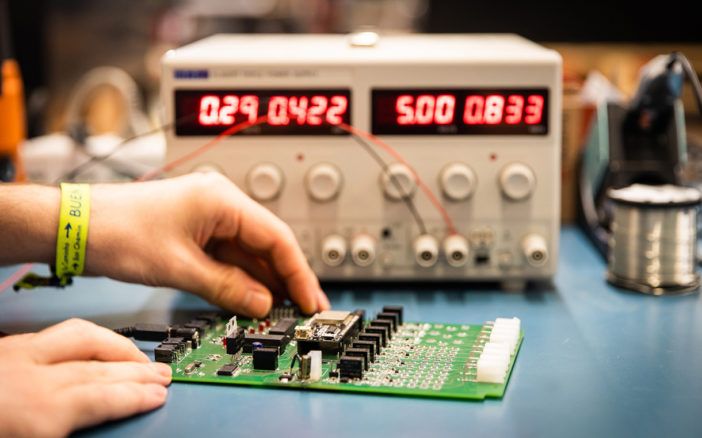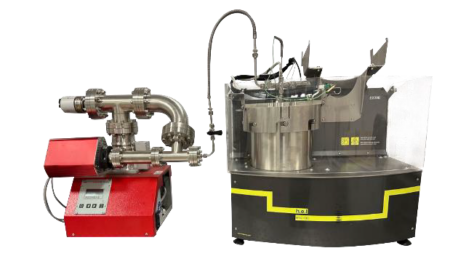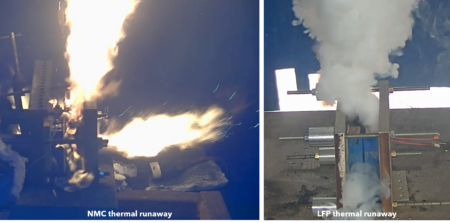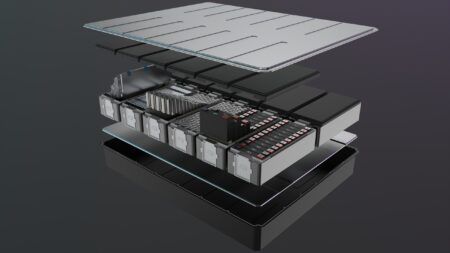Are lithium batteries safe or are they a risk for users? The answer is closely linked to the design phase: from research and development to choosing the most appropriate materials, right up to correct assembly. These are the factors that ensure their safety over time. We will talk about it here with Flash Battery, a lithium battery manufacturer for industrial sector.
An increasing number of industrial vehicles and machines are going electric, with a view to sustainability and to reducing their environmental impact. However, as with any change, the green transition can cause a few concerns. Lithium batteries are still surrounded by the generalised and often incorrect belief that they are unreliable and more likely to cause fires. In fact, you do not have to look far online to find shocking news articles and pictures about lithium batteries that caught fire and caused damage to people and property, but we should not tar them all with the same brush and it is essential to share accurate, correct information.
The manufacturer plays an essential role in the safety of a battery: if the design is done roughly, if the wrong chemistry or inefficient electronics are used or if assembly is not carried out carefully, then there can be a real risk of fire. It is therefore important to trust experienced battery manufacturers, who run specific technical tests and carefully select the components and electronics, right from the research and development phase.

It is precisely because of its decade of experience in designing and manufacturing lithium batteries for the industrial vehicle and machinery sector that we asked Flash Battery (https://bit.ly/3EMKdhZ) to shed some light on the 3 essential aspects to focus on when designing a safe battery pack. Let’s have a look at them in more detail.
The choice of the right chemistry
There are various lithium chemistries available on the market, but they do not all have the same properties and each one works best in different user conditions. For example, the famous NMC (Nickel, Manganese and Cobalt) and NCA (Nickel, Cobalt, and Aluminium), even though they are intrinsically less safe, are widely used in the automotive world, as this requires high energy density to be able to provide so much power in such little space. While the industrial world has very different needs: the problem of space is less restricting and when assessing the chemistry, factors are involved such as the requirement for a high level of safety and the need for long life cycles, due to vehicles’ work cycles, which are often intense and can last several hours in a row. A very specific chemistry therefore comes into play, i.e., LFP (lithium-iron-phosphate), which is king in terms of safety and lifespan.

But what is the main reason for the intrinsic safety of LFP chemistry? The answer lies in its high decomposition temperature and slow heat release. In fact, the higher the temperature, the more difficult it is to enter decomposition conditions, therefore facilitating the intrinsic safety of the cell. The heat released, which is measured in Joules per gram, also indicates the energy that the battery cell can release in the form of heat, therefore contributing to the increase in temperature.
This combination helps avoid thermal runaway, i.e., a domino effect that occurs among the battery cells, where the temperature increase creates the conditions for a further increase in temperature, which in turn causes an imbalance in the system that could potentially lead to a fire.
By working for the industrial vehicle and machinery market, ever since Flash Battery was founded in 2012, it has chosen to use LFP chemistry, which best meets the specific needs of this sector, giving vehicles and machines a long life (over 4,000 charge cycles) and proving to be the safest and most stable choice on the market. It is also available in the large-capacity formats required in industrial applications, so there is no need to connect a great number of small cells in parallel, which would lower their stability and could compromise the safety of the entire machine.
“Our goal”, explained the founder and CEO of Flash Battery, “has always been to identify the safest battery technology for the customer’s vehicle or machine. Our R&D department does not just deal with the theoretical study of chemistries, but it also runs different tests to “stress” the batteries and test out improvements. One of these, for example, is the Nail Penetration Test, which involves piercing a battery with a nail, simulating an internal short-circuit. These tests are clearly conducted in a laboratory, under controlled safety conditions, and the likelihood that a cell is penetrated during normal use in a lithium battery installed in industrial machinery and vehicles is incredibly low. However, we take this test into consideration because it simulates the worst thing that could happen to a cell, i.e., an internal short-circuit, which can occur due to potential manufacturing faults or misuse”.
Never underestimate the assembly of the cells that make up the battery
After chemistry, the assembly of the cells is the second element that determines the safety of a lithium battery. More specifically, it is the number of parallel cells inside the pack that makes the difference.

If a battery is assembled with small cells, to reach the desired capacity, you need to add a very high number of parallel cells. Safety becomes a problem when one of these cells short circuits: in this case, the faulty cell absorbs the energy of all the other parallel cells, which will cause its temperature to rise exponentially and could compromise the safety of the pack. To prevent this problem, it is best to use prismatic cells, which can pack in higher capacities and therefore help reduce the number of parallel cells.
“Let’s look at a practical example”, Mr Righi continued, “let’s take the case of a 400Ah battery: if it was made up of 3Ah cylindrical cells, you would need 130 parallel cells, while if it was made up of 50Ah prismatic cells, you would only need 8 parallel cells. So, if one of these cells short circuits, in the first case it would absorb 130 times its capacity, but only 8 times in the second case. Flash Battery lithium batteries are made with a maximum of 4 parallel prismatic cells. According to our research, this is the best structure so our batteries can guarantee their safety in any situation”.
Smart control electronics prevent damage to your vehicles
The third and final essential aspect for guaranteeing the safety of the entire lithium battery pack concerns the electronics controlling the battery, i.e., its Battery Management System.
What makes the difference among all the various lithium battery manufacturers is how their control electronics work in hazardous situations: in fact, one of the main tasks of the BMS is to keep the cells balanced, to monitor all the battery parameters in real time as well as the temperature of individual cells, while also interacting with the vehicle and battery charger.
If overheating is one of the main issues to be prevented to ensure the safety of a lithium battery, then constant monitoring of the internal temperature therefore becomes an essential task. In fact, one of the various functions of a smart BMS is also: to constantly check the temperature and the voltage of individual cells, to interact with the vehicle and with the battery charger to stop it from charging and discharging in the event of a critical issue and, potentially, to trip the general remote contactors.
In fact, many traditional systems do not thoroughly check the temperature, which is often monitored every 3-4 cells and not always at the right points. To make a pack safe, these measurements must be carried out more comprehensively.
 Flash Battery was founded from studying the critical issues that used to occur in the past with the electronics and limited the reliability and safety of lithium batteries. This is where it all began for this Italian company over 11 years ago and this has been its focus point to stand out from other manufacturers, developing a proprietary battery management system, now patented and the only one of its kind, which keeps cells balanced and efficient in every respect.
Flash Battery was founded from studying the critical issues that used to occur in the past with the electronics and limited the reliability and safety of lithium batteries. This is where it all began for this Italian company over 11 years ago and this has been its focus point to stand out from other manufacturers, developing a proprietary battery management system, now patented and the only one of its kind, which keeps cells balanced and efficient in every respect.
“It is called the Flash Balancing System”, explained the founder of Flash Battery. “It is a high-power balancing system that works both actively during discharging as well as actively and passively during charging, with a balancing current that far exceeds traditional BMS systems (20A), while keeping cells balanced, making charging times shorter and more predictable and checking all the temperatures with 2 sensors on every cell”.
Flash Battery’s BMS does not just balance cells. It was designed to perform constant and comprehensive checks on every battery pack that ensure stability over time, preventing faults and allowing for self-diagnostics and predictive maintenance. To do this, the main partner of the Flash Balancing System is the Flash Data Center, the proprietary remote-control portal that uses artificial intelligence algorithms to provide 24/7 monitoring of the state of health of all the 18,000+ Flash Battery batteries in operation around the world, while running advanced and predictive analysis of big data to improve machine performance and to create new generations of increasingly smart lithium batteries.





